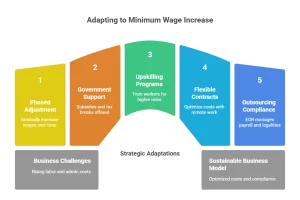Spain’s minimum wage (Salario Mínimo Interprofesional, SMI) has taken another leap in 2025, and if you’re a worker, business, or someone planning to hire in Spain, this matters. The government has set the SMI at €1,184 per month (in 14 payments), which amounts to €16,576 per year.
Over the years, this wage floor has risen sharply – a 61% increase since 2018 and continues to be a central instrument in Spanish social and labor policy. But the hike is not free of trade-offs. In this guide, I’ll walk you through what the minimum wage in Spain is now, how it works (monthly, daily, hourly), its history, its economic effects, and what challenges and strategies businesses face in adapting to it.
Iberia EOR also plays a role in helping businesses manage compliance and payroll in Spain – they simplify dealings with Spain’s labour law, benefits, and regulations so you can focus on operations.
Let’s get started.
What Is the Minimum Wage (SMI) in Spain?
The minimum wage in Spain is legally referred to as the Salario Mínimo Interprofesional (SMI). It’s the lowest gross wage an employer can legally pay a full-time worker under the law, regardless of age, sector, or region.
How it’s determined:
- Each year, the Spanish government issues a Royal Decree setting the SMI after consultation with unions and employer bodies.
- The figure is gross, before taxes and social contributions.
- Even if someone works part-time, the wage is adjusted pro rata, based on hours worked.
- There is no regional variation – the SMI is uniform across all autonomous communities.
This makes the SMI a strong baseline under Spain labour law, helping protect lower-wage workers.
Minimum Wage in Spain in 2025: Monthly, Annual, and Daily Rates
Here are the up-to-date figures for 2025:
- Monthly (14 payments): €1,184 gross
- Annual (14 payments): €16,576 gross
- Daily rate: €39.47 gross (for full working days)
- 12-payment alternative: If extra payments are prorated, the monthly wage becomes ~€1,381 (so the annual total is the same)
This increase of €50/month over the previous year was applied retroactively from January 1, 2025.
It’s important to note that in the past, the SMI in Spain was significantly lower. For instance, before recent rises, the 2024 SMI was about €1,134 per month in 14 payments.
Minimum Wage per Hour in Spain
For workers paid hourly – such as domestic help, seasonal workers, or part-time roles – Spain has specific rules:
- Hourly wage for domestic/household workers: €9.26 per hour
- Daily rate for temporary / seasonal workers (services less than 120 days): €56.08/day
If someone works fewer hours, pay is adjusted proportionally.
So when someone asks “minimum wage per hour Spain”, that’s the relevant figure, especially for hourly/domestic workers.
Evolution of Spain’s Minimum Wage Over the Years
Let’s take a quick journey through how the SMI has evolved and why.
Growth from 2018 to 2025
|
Year |
SMI (monthly, 14 payments) |
Annual (14 payments) |
Approx Increase Since 2018* |
|
2018 |
~€736 |
– |
– |
|
2020 |
~€1,108 |
– |
– |
|
2023 |
~€1,080 |
– |
– |
|
2025 |
€1,184 |
€16,576 |
+61% (≈ +€6,273) |
According to Spanish government sources, the increase from 2018 to 2025 has been 61%.
This is one of the steepest increases in a single seven-year window in Spain’s recent history.
Why the Increases?
Several reasons drive this upward trend:
- Combating inequality and in-work poverty – raising the floor helps lower-income workers.
- Aligning with EU benchmarks – many European countries have higher minimum floors, putting pressure on Spain.
- Political will & social contract – unions and workers’ rights groups pushing for better living standards.
- Inflation and cost-of-living concerns – rising rents, energy, food push the need for wage adjustments.

Spain’s approach is that SMI updates should not lag too far behind inflation, so that the minimum wage remains a relevant social safety net.
How Does Spain’s Minimum Wage Compare in the EU?
Putting Spain’s numbers in perspective:
- France has a statutory minimum wage amounting to nearly €20,000 per year – significantly higher.
- Portugal is much lower, around €10,000/year in many cases.
- Spain, with €16,576/year, sits somewhere in the middle of the pack in the EU.
That said, one must account for cost of living, purchasing power, and social services. What looks high or low in absolute euros can feel very different depending on region.
Spain’s SMI system was formally codified in Law 8/1980, and the government must consult social partners when setting the wage each year.
Effects of Minimum Wage on Spain’s Economy
Raising the minimum wage isn’t just about income – it has ripple effects across the economy. Here’s what research and official sources say.
Advantages
- Benefiting low-income workers: The 2025 SMI increase will directly help ~2.4–2.5 million workers.
- Boosting consumption: Lower-income households tend to spend more of extra income, which can stimulate aggregate demand.
- Narrowing inequality: The SMI rise is explicitly framed as reducing wage gaps and improving social equity.
- Spillover wage pressure: Workers slightly above the SMI may negotiate higher pay too.
- Morale and productivity uplift: When workers feel fairly paid, firms may see benefits in retention and motivation.
Disadvantages / Risks
- Cost pressure on businesses: Especially for small and medium enterprises (SMEs), wage bills rise significantly.
- Potential job losses or reduced hiring: Critics argue that firms may cut roles or avoid hiring in low-margin sectors.
- Inflation / price pass-through: Some of the extra wage cost can flow into higher prices for goods and services.
- Automation & substitution: Firms may invest more heavily in automation to reduce human costs.
What Does Empirical Research Show?
- A study on Spain’s 2019 minimum wage hike (22% rise) found that monthly earnings of affected workers increased by ~5.8%, while employment fell by ~0.6 percentage points, implying a modest negative employment elasticity.
- A matched employer-employee study for 2025 observed wage growth increases and some moderation in employment growth, though results vary depending on sector.
- Historical analysis between 2010 and 2023 shows a modest negative correlation between minimum wage rises and unemployment in many groups (Pearson values between –0.4 and –0.6).
- Another Spanish working paper estimates that, due to the hike, some firms reduced employment growth, but consumption effects (from higher incomes) offset part of that decline.
Overall, research suggests net gains in income for many, with employment effects being modest and concentrated in vulnerable sectors rather than mass layoffs.
Challenges for Businesses in Adapting to the New Minimum Wage
Good intentions aside, implementing the SMI increase is no small feat for businesses. Here’s what they face:
- Rising labor costs – Payrolls swell, especially in industries with many low-wage roles (hospitality, retail, agriculture).
- Cash flow pressure – Smaller firms may struggle to absorb the increase all at once.
- Compliance & administrative burdens – Adjusting payroll systems, recalculating salaries, proving legal compliance.
- Competition & pricing – Some firms may raise prices or compress margins.
- Contract types & segmentation – Firms with many part-time or temporary workers may shift hiring strategies.
Possible Solutions & Strategies
- Phased adjustment / smoothing: Gradually ramping up wages to spread cost.
- Government supports & incentives: Subsidies or tax breaks for small firms, especially in rural/low-margin sectors.
- Upskilling & reskilling programs: Move workers to roles with more productivity, making wage increases more viable.
- Flexible contracts & work modalities: Use remote work, compressed schedules, or variable hours to optimize costs.
- Outsourcing compliance using EOR services: An Employer of Record (EOR) can manage contracts, payroll, legal compliance, and social security filings – reducing administrative burden.

For foreign companies planning to set up a company in Spain or operate with local teams, partnering with an EOR avoids deep dives into Spanish HR rules and allows smoother entry into the market.
Conclusion & Outlook
The minimum wage in Spain is now €1,184/month (14 payments), amounting to €16,576/year, a move aimed at improving living standards and reducing inequality. This is part of a strong upward trend – a 61% increase since 2018. While the wage hike benefits millions, it also creates challenges for SMEs and firms in low-margin sectors.
Looking ahead, Spain must balance further increases with business sustainability. The government has hinted at further SMI revaluations later in 2025.
If your business is expanding or hiring in Spain, working with an EOR service smooths the path through compliance, payroll, and labor regulations.
FAQs About Minimum Wage in Spain (2025)
What Is the Minimum Wage in Spain in 2025?
€1,184 per month (14 payments), or €16,576 per year.
How Much Is the Minimum Wage per Hour in Spain?
For domestic/household work: €9.26 per hour. For temporary/seasonal workers: ~€56.08 per day.
Is Spain’s Minimum Wage Gross or Net?
It’s gross – before taxes and social security deductions.
Do All Workers in Spain Receive the Same Minimum Wage?
Yes, the SMI is uniform nationwide – no regional or sectoral variations.
Does the Increase Apply to Seasonal and Domestic Workers?
Yes – hourly and daily rates ensure the minimum wage covers these roles.
How Does Spain’s Minimum Wage Compare with France and Portugal?
It’s lower than France’s but higher than Portugal’s, putting Spain in the middle among EU countries.
Does Higher Minimum Wage Lead to Unemployment?
Research suggests modest negative employment effects in certain sectors, but net income gains and consumption effects often offset major downsides.






